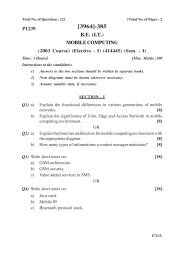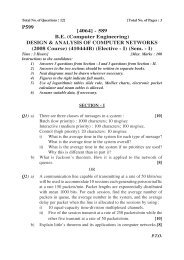Cloud Computing and SOA Convergence in Your Enterprise: A Step ...
Cloud Computing and SOA Convergence in Your Enterprise: A Step ...
Cloud Computing and SOA Convergence in Your Enterprise: A Step ...
You also want an ePaper? Increase the reach of your titles
YUMPU automatically turns print PDFs into web optimized ePapers that Google loves.
Governance for the <strong>Cloud</strong>s 149<br />
form know that a service was chang<strong>in</strong>g. You can consider this a dance that<br />
<strong>in</strong>cludes those charged with design<strong>in</strong>g <strong>and</strong> build<strong>in</strong>g the architecture, those<br />
who operate the systems with<strong>in</strong> the enterprise, <strong>and</strong> those who operate the<br />
systems with<strong>in</strong> the clouds. If they do not all come together on service governance,<br />
it simply will not work no matter what technology you leverage or<br />
how good it is.<br />
Governance for the <strong>Cloud</strong>s<br />
We do governance for the simple reason that once we get to a certa<strong>in</strong> number<br />
of services, we will not be able to keep track of them all <strong>and</strong> provide the control<br />
they require. Those who build <strong>SOA</strong> call this the “tipp<strong>in</strong>g po<strong>in</strong>t,” or the<br />
po<strong>in</strong>t at which the number of services under management becomes so high<br />
that it is impossible to manage them properly without a governance model,<br />
approach, <strong>and</strong> service governance technology.<br />
The number of services, as well as the complexities around us<strong>in</strong>g those<br />
services with<strong>in</strong> the context of cloud comput<strong>in</strong>g, makes service governance<br />
even more compell<strong>in</strong>g; they <strong>in</strong>clude<br />
Location of the services<br />
Service dependencies<br />
Service monitor<strong>in</strong>g<br />
Service security<br />
Many of the services are not hosted <strong>and</strong> owned by the bus<strong>in</strong>ess; they are<br />
cloud-based, so controls must be placed around them to mediate the risks.<br />
What is important when leverag<strong>in</strong>g on-premise <strong>SOA</strong>s is even more important<br />
<strong>in</strong> the world of cloud comput<strong>in</strong>g. In essence, we use the “trust but verify”<br />
model, plac<strong>in</strong>g a layer of processes <strong>and</strong> technology around the services<br />
so that every event, such as a change to services or a service failure, is quickly<br />
known, allow<strong>in</strong>g us to take corrective action or perhaps allow<strong>in</strong>g the technology<br />
to self-correct (see Figure 8.3).<br />
When consider<strong>in</strong>g the end-state architecture as a comb<strong>in</strong>ation of <strong>SOA</strong><br />
<strong>and</strong> cloud comput<strong>in</strong>g, we are look<strong>in</strong>g to build a series of services that are<br />
formed <strong>and</strong> reformed to build bus<strong>in</strong>ess solutions. The services may exist onpremise<br />
or may be cloud delivered, but the use of those services by applications<br />
<strong>and</strong> processes, as well as their location, should be completely transparent<br />
to the service consumer.












